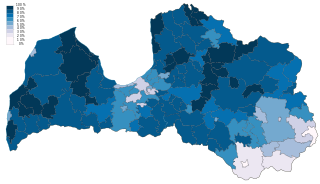
Parliamentary elections were held in Latvia on 5 October 2002. The New Era Party emerged as the largest party in the Saeima, winning 26 of the 100 seats.

Parliamentary elections were held in Latvia on 5 and 6 June 1993, the first after independence was restored in 1991. Latvian Way emerged as the largest party in the Saeima, winning 36 of the 100 seats. A total of 23 parties participated in the elections, although only eight received 4% or more of votes and won seats. Voter turnout was 91.2%, the highest in the country's history. Only 66–75% of Latvian residents qualified to vote, with the majority of those not able to vote being Russian.

Parliamentary elections were held in Latvia on 7 October 2006. The governing coalition, led by Prime Minister Aigars Kalvītis and his People's Party, won the election. Kalvitis's government thus became the first to be re-elected since Latvia had regained independence in 1991.

Constitutional Assembly elections were held in Latvia on 17 and 18 April 1920. The Latvian Social Democratic Workers' Party emerged as the largest party, winning 57 of the 150 seats. The elections were boycotted by communist parties. The Constitutional Assembly was responsible for drafting a constitution, which was approved on 15 February and promulgated on 7 November 1922.

A referendum on the Insurance Law was held in Latvia on 24 and 25 February 1934. The referendum was initiated by the Latvian Social Democratic Workers' Party and its supporters and asked voters whether they approved of the law "On Provision in cases of old age, disability and unemployment", more commonly known as the Insurance Law. The law would provide social protection for the elderly, disabled and unemployed. Although it was passed by a wide margin, voter turnout was below the necessary threshold and the law was not passed by the Saeima.

Parliamentary elections were held in Latvia on 7 and 8 October 1922. The Latvian Social Democratic Workers' Party remained the largest party, winning 30 of the 100 seats.

Parliamentary elections were held in Latvia on 3 and 4 October 1925. The Latvian Social Democratic Workers' Party remained the largest party, winning 32 of the 100 seats.

Parliamentary elections were held in Latvia on 6 and 7 October 1928. The Latvian Social Democratic Workers' Party remained the largest party, winning 25 of the 100 seats.

Parliamentary elections were held in Latvia on 3 and 4 October 1931. The Latvian Social Democratic Workers' Party remained the largest party, winning 21 of the 100 seats. The last elections held under the Constitution of Latvia before the 1934 coup d'état, they were the last competitive elections held under Latvian law until 1993.

The Latgalian Farmers Party was a political party in Latvia representing the interests of Latgale farmers during the inter-war period.

The Democrats Union was a political party in Latvia in the inter-war period.

The Workers' Party was a political party in Latvia.

The Latgalian Christian Peasant and Catholic Party was a Christian centrist political party in Latvia during the inter-war period. It was the largest party in the Latgale region, and was led by the bishop Jāzeps Rancāns.

The United Polish Parties, officially the Educational and Charity Associations of Riga and the Polish Association in Latvia, was a political alliance in Latvia for Latvian Poles during the inter-war period.

The Non-Partisan Landless Farmers, officially the Group of Latvian Non-Partisan Landless and Small Farmers, was a political party in Latvia in the early 1920s.
The Democratic Centre, officially the Democratic Centre and Non-Partisan Public Workers, was a political party in Latvia in the inter-war period.

The Latgalian Farmer-Labour Party, also known as the Latgalian Progressive Farmers, was a political party in Latvia during the inter-war period. The party contested elections in an alliance with several other parties under the name United List of Latgalian Small Landless Farmers and Latgalian Labour Party. It was led by Jezups Trasuns.

The Latgalian People's Party was a political party in Latvia in the inter-war period.



